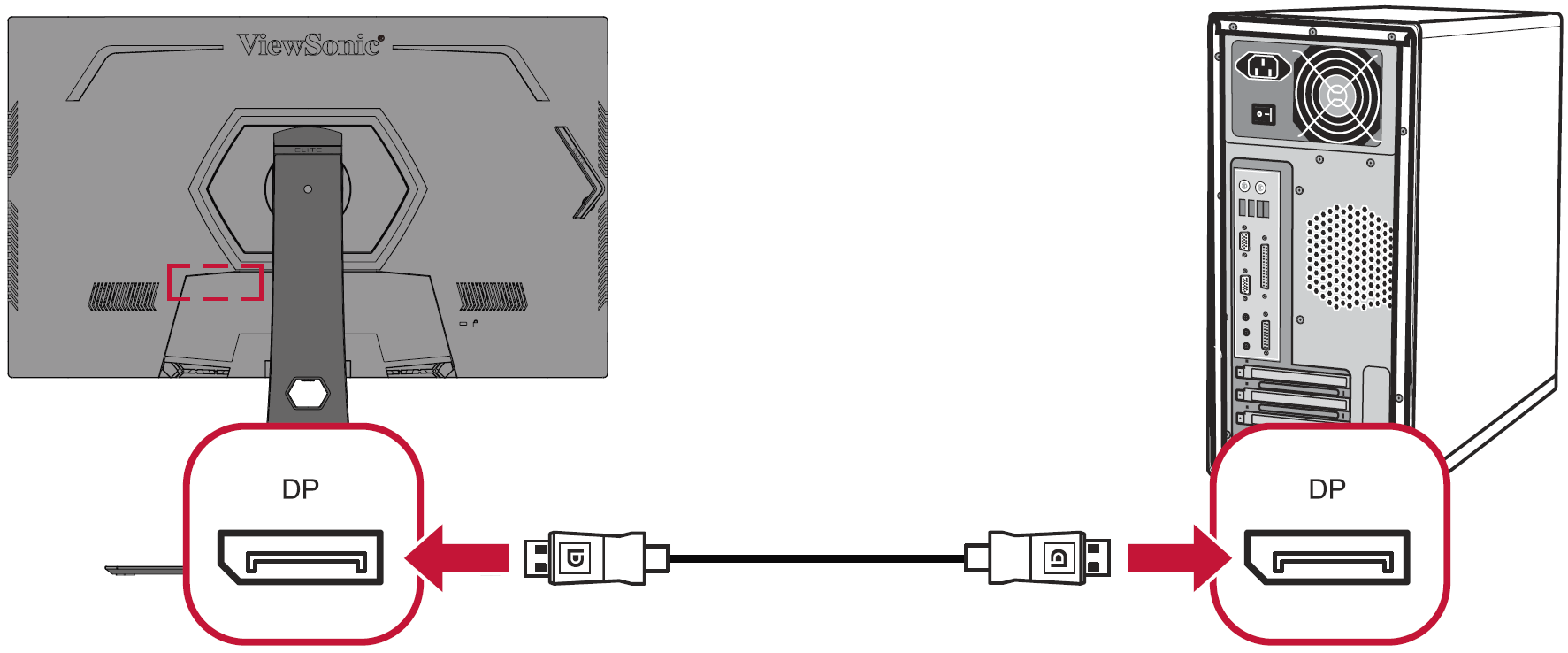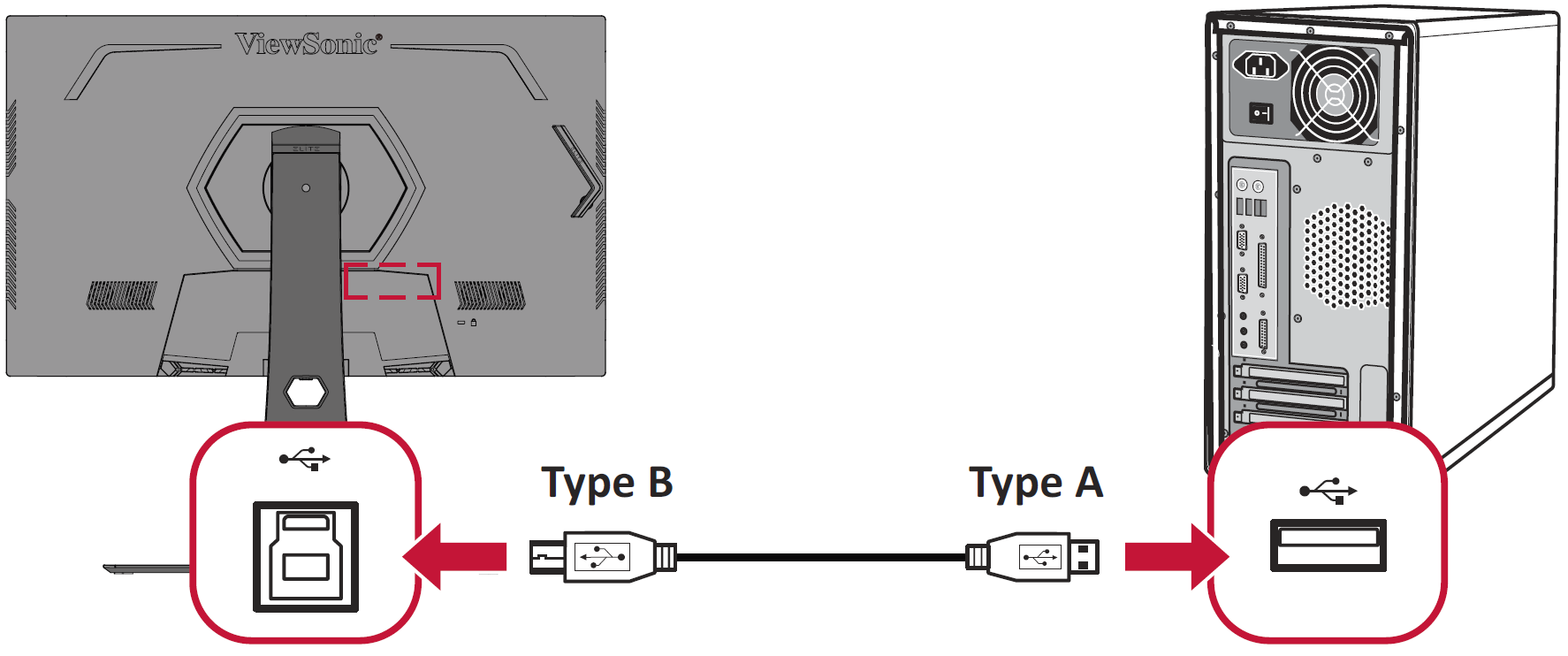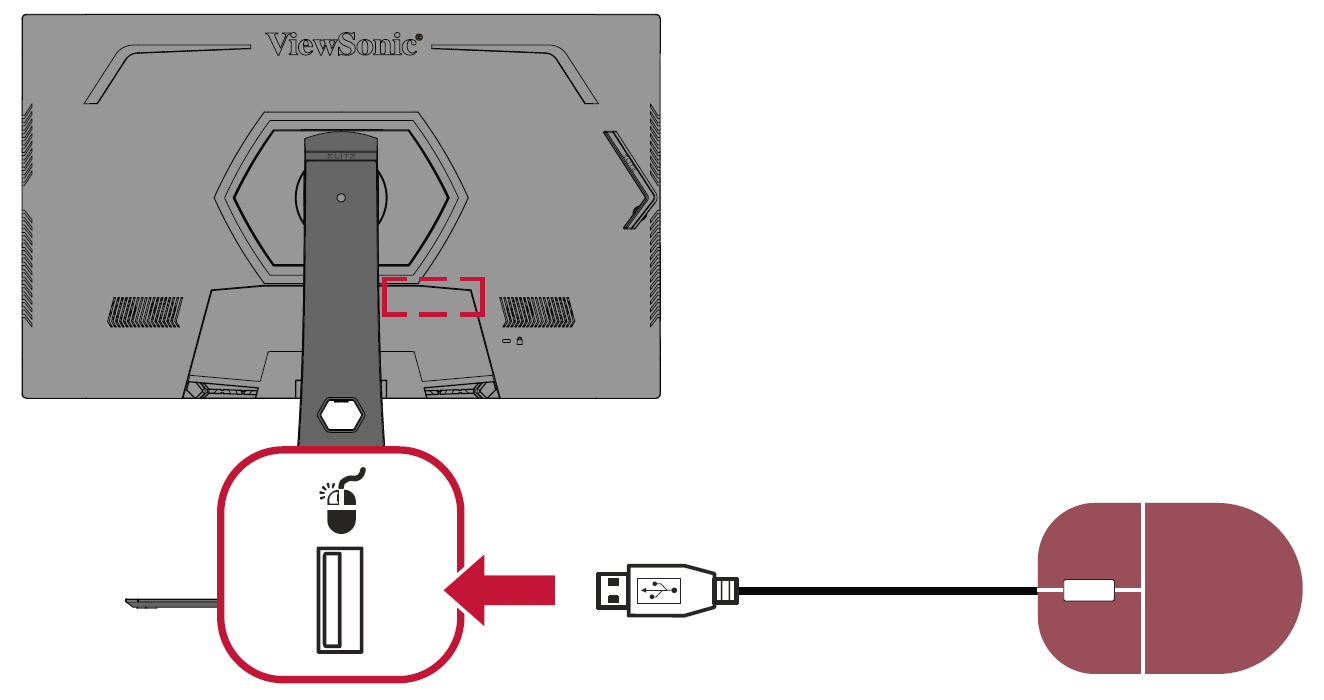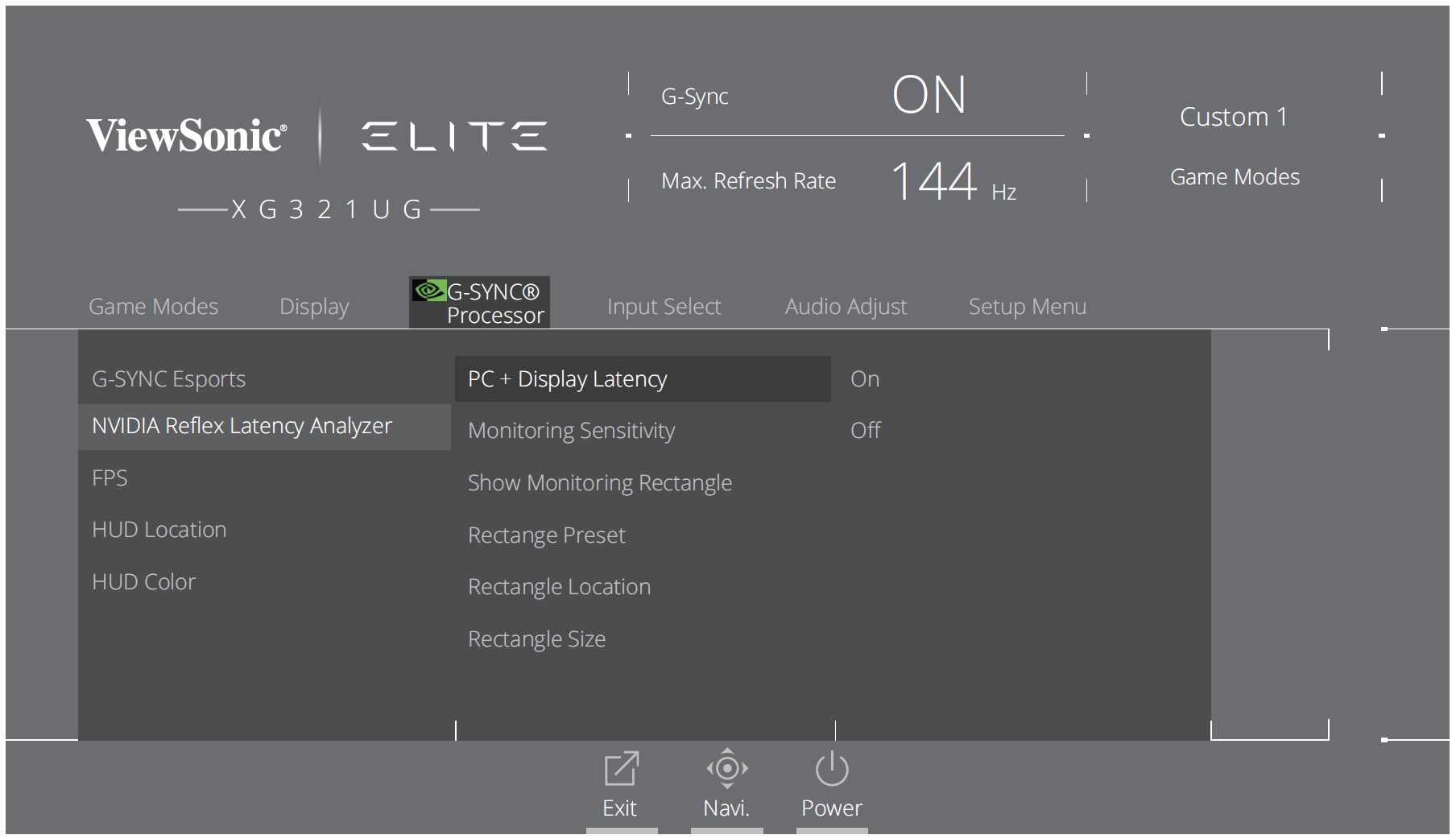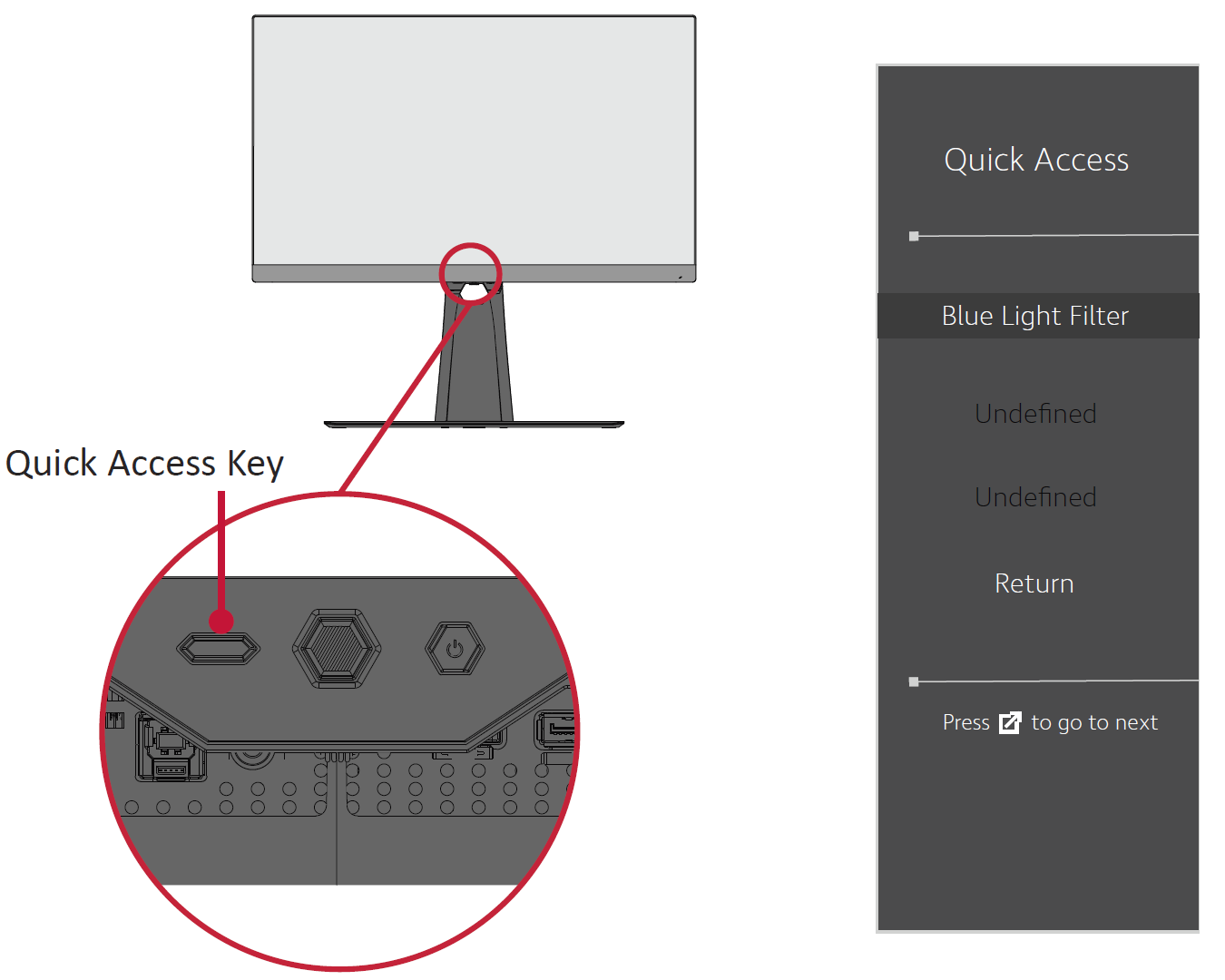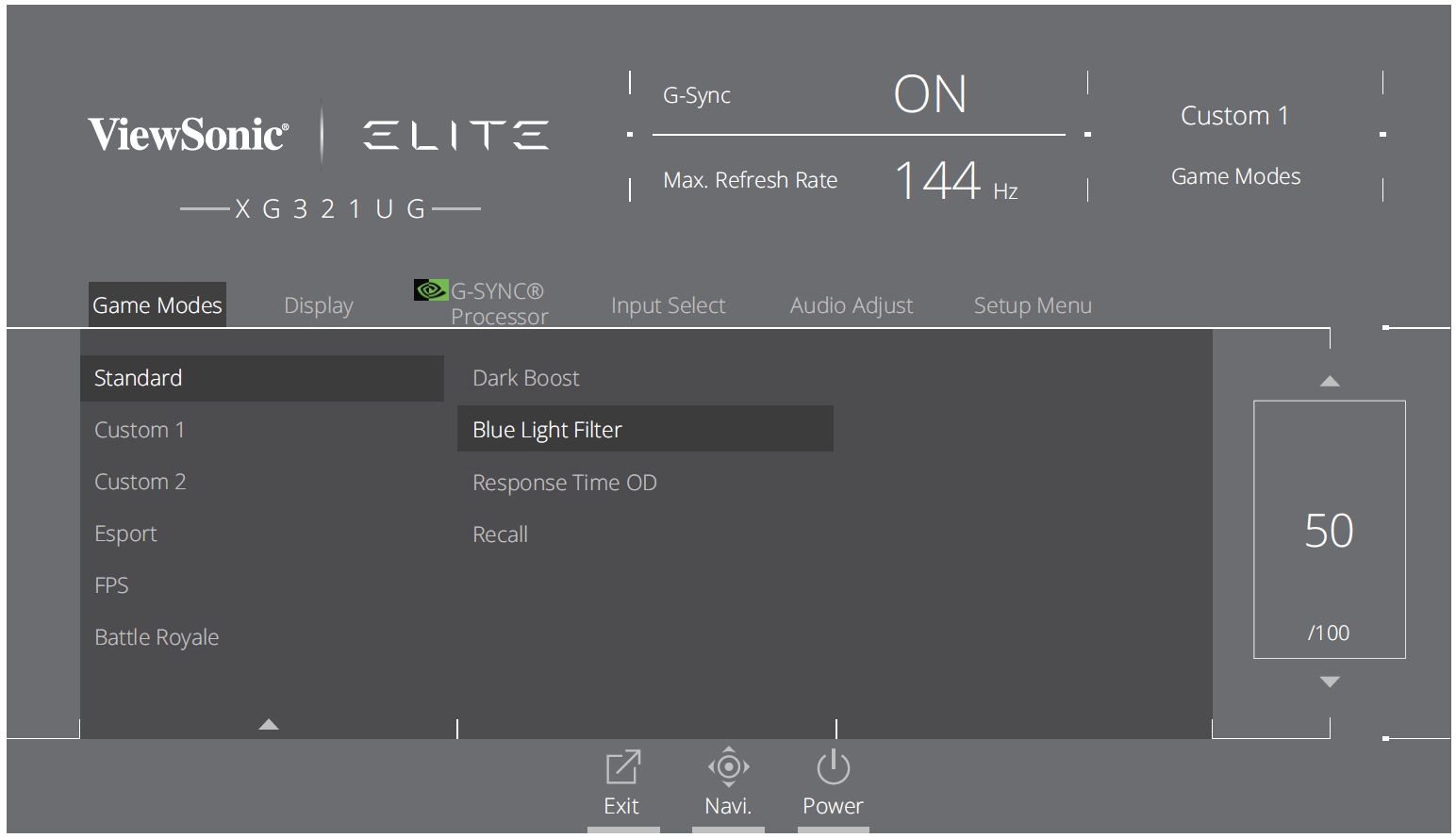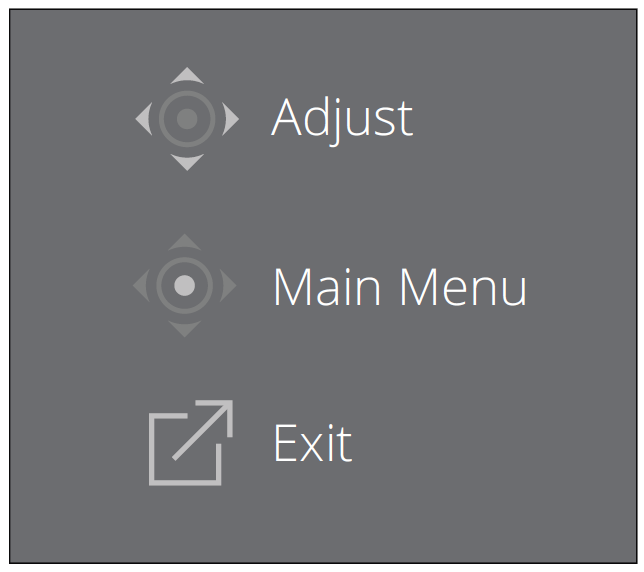XG321UG Advanced Features and Settings
NVIDIA Reflex Latency Analyzer
NVIDIA Reflex is a technology designed to reduce the input lag between your peripheral devices (e.g., mouse) and your PC/display to reduce latency and help improve your performance and in-game experience.
To use the NVIDIA Reflex Latency Analyzer:
- Connect the monitor, via DisplayPort, to your GeForce GPU.
- Ensure the USB Type B cable is connected to the monitor and your computer.
- Connect your NVIDIA Reflex compatible mouse to the USB Type A port at the rear of the monitor labeled with the mouse icon.
- Turn on the NVIDIA Reflex Latency Analyzer in the monitor’s OSD Menu:
- Press the [●] key or move the joy key [◄] or [▲] or [▼] to display the On-Screen Display (OSD) Menu.
- Using the joy key, go to: G-SYNC Processor > NVIDIA Reflex Latency Analyzer > PC + Display Latency > On.
- Setup the Monitoring Rectangle. The NVIDIA Reflex Latency Analyzer measures flashes or bright changes on the screen. The measurements are taken within the Monitoring Rectangle.
- Press the [●] key or move the joy key [◄] or [▲] or [▼] to display the On-Screen Display (OSD) Menu.
- Using the joy key, go to: G-SYNC Processor > NVIDIA Reflex Latency Analyzer > Rectangle Location to adjust the location of the Monitoring Rectangle.
- NOTE:
- A preset location can be chosen under Rectangle Preset.
- The Monitoring Rectangle’s size can be adjusted under Rectangle Size.
- NOTE:
- Now the PC + Display Latency will be able to be measured by pressing the left mouse button.
To measure latency, the Monitoring Rectangle will need to be moved over a location on screen where a flash or change in brightness will occur when the left mouse button is pressed (e.g, placed over the muzzle of a firearm in an FPS game).
In the OSD Menu:
To learn more, visit: https://www.nvidia.com/en-us/geforce/news/reflex-latency-analyzer-360hz-g-sync-monitors/.
Blue Light Filter and Eye Health
The Blue Light Filter blocks high-energy blue light for a more comfortable viewing experience.
Quick Access Blue Light Filter Setup
Enabling and disabling the Blue Light Filter can be done on the fly via the Quick Access Key.
- NOTE: When enabling the Blue Light Filter (BLF) via the Quick Access Key, the BLF value will be 100 which is certified by TÜV. However, the BLF value will be 0 if the user chooses another function via the Quick Access Key.
While using and enjoying your monitor please keep the following in mind:
- Viewing computer screens for extended periods of time may cause eye irritation and discomfort. To reduce these effects, it is recommended to take periodic breaks from viewing to allow the eyes to relax.
- Users can customize the Blue Light Filter value through the Game Modes Menu.
- The monitor also supports Flicker-Free, which reduces or eliminates screen flicker, thus easing potential eye strain.
Calculating Breaks
When viewing the monitor for extended periods, it is recommended to take periodic breaks from viewing. Short breaks of at least five (5) minutes are recommended after one (1) to two (2) hours of continuous viewing. Taking shorter, more frequent breaks are generally more beneficial than longer, less frequent breaks.
Looking at Distant Objects
While taking breaks, users can further reduce eye strain and dryness by focusing on objects that are further away from them.
Eye and Neck Exercises
Eye Exercises
Eye exercises can help minimize eye strain. Slowly roll your eyes to the left, right, up, and down. Repeat as many times as needed.
Neck Exercises
Neck exercises can also help minimize eye strain. Relax your arms and let them hang at your sides, bend forward slightly to stretch the neck, turn your head to the right and to the left. Repeat as many times as needed.
Quick Access
Quickly initiate some functions and modes through the Quick Access key and menu. Users can also define which functions or modes they prefer in the Quick Access Menu via the Setup Menu in OSD. The function/mode will be enabled as soon as the light-bar moves on the item, and will disable after removing the light-bar.
In the Quick Access Menu, “Return” means users can “automatically” go back to the mode they chose before entering the Quick Access Menu.
For example, if users chose “Console Speed” mode before entering the Quick Access Menu and there is an existing FPS option in the Quick Access Menu, according to the Quick Access definition, users will enable FPS mode when the light-bar moves on the item. Then, when moving the light-bar to “Return,” the mode will be changed into “Console Speed” automatically which is same as the mode before user entering the Quick Access Menu.
To activate the Quick Access Menu:
- Press the Quick Access Key to display the Quick Access Menu.
- Press the Quick Access Key to select your preference.
- NOTE:
- To change the Quick Access Menu’s default functions (Blue Light Filter, PureXP™, and OverClocking), remove one or more default functions via the OSD Setup Menu first.
- The Quick Access Menu will disappear after three (3) seconds automatically.
- NOTE:
To change the Quick Access Menu options:
- Press the [●] key or move the joy key [◄] or [▲] or [▼] to display the On-Screen Display (OSD) Menu.
- Move the joy key [◄] or [►] to select Setup Menu. Then move the joy key [▼] to enter the Setup Menu menu.
- Move the joy key [▲] or [▼] to select Quick Access. Then move the joy key [►] to enter its sub-menu.
- Move the joy key [▲] or [▼] to select your preference. Then press the [●] key to confirm the selection.
- NOTE: Some sub-menu options may have another sub-menu. To enter the respective sub-menu, move the joy key [►].
Elite RGB Lighting
This setting controls the RGB lighting on the back of the monitor and beneath the bezel. When “On”, or after being reset, the default ‘Breathing’ mode will be active.
To enter the Elite RGB menu:
- Press the [●] key or move the joy key [◄] or [▲] or [▼] to display the On-Screen Display (OSD) Menu.
- Move the joy key [◄] or [►] to select Setup Menu. Then move the joy key [▼] to enter the Setup Menu menu.
- Move the joy key [▲] or [▼] to select Elite RGB. Then move the joy key [►] to enter its sub-menu.
- Move the joy key [▲] or [▼] to select your preference. Then press the [●] key to confirm the selection.
- NOTE: Some sub-menu options may have another sub-menu. To enter the respective sub-menu, move the joy key [►].
In addition, the RGB backlights are also synced with several key partners. Downloading their software will give you the power to adjust your RGB capabilities further.
To setup up partner RGB software:
- Visit: https://www.viewsonic.com/elite/rgb/
- Select a partner RGB software, and download it.
- Connect one end of the USB Type B cable to the monitor and the other end to your computer.
- Run and install the partner software.
- Start customizing the monitor’s RGB lighting.
Crosshair
Select from different crosshair styles and colors to overlay on your screen.
To enable the Crosshair function:
- Press the [●] key or move the joy key [◄] or [▲] or [▼] to display the On-Screen Display (OSD) Menu.
- Move the joy key [◄] or [►] to select Setup Menu. Then move the joy key [▼] to enter the Setup Menu menu.
- Move the joy key [▲] or [▼] to select Crosshair. Then move the joy key [►] to confirm the selection.
- Move the joy key [▲] or [▼] to select your preferred crosshair style and color. Then press the [●] key to confirm the selection.
- NOTE: A preview image of the crosshair (type and color) will be displayed on the right side of the OSD Menu before confirming.
| Crosshair | Description |
|---|---|
| Type A | 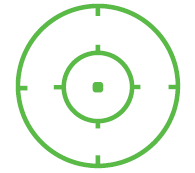
|
| Type B | 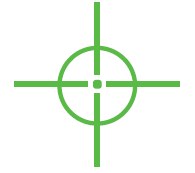
|
| Type C | 
|
| NOTE: This message box will appear with the crosshair, and disappear after three (3) seconds automatically. |

